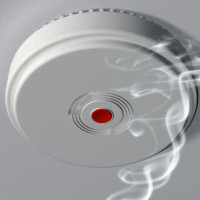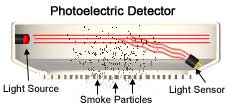Forget about the terminologies for a moment.
It is the function and application that matters……..This article will help you understand photoelectric and ionization smoke detectors in an easier way.
Generally there are two broad categories of smoke detectors: the photoelectric smoke detector and the ionization smoke detector.
Most people wonder, which one is better between the two? Well, it depends with your application.
Contents
Photoelectric Smoke Detector Working Principle
Photoelectric effect is a phenomenon that takes place on most metals when light falls on them and forces them to emit electrons.
Electrons are very small particles at the atom level with negative charge. (if you can recall your high school science). When these electrons are made to flow, they generate electric current.
For the photoelectric smoke detector, there is a light source and a photo detector that senses the light.
They are not positioned in a straight line and therefore under normal circumstances, the photo detector will not sense any light. In case of smoke entering the detector, some of the light is scattered towards the photo detector sensor. This triggers the alarm. It is as simple as that.
Having said that, it is good for you to know that smoke alarms have responsive time. This is the difference between the time a fire starts and the time the fire alarm goes off.
To ensure you are protected, we want this responsive time to be as small as possible. The type of smoke detector that you should have in your home should go off immediately there is a fire.
The photoelectric smoke detector is more responsive to fires that burn without flame.
This kind of fire undergo slow or suppressed combustion. There is no outward demonstration of fire and are often referred to as smoldering fire.
How do ionization smoke detectors work ?
On the other hand, ionization smoke detector is more responsive to flaming fires.
The photoelectric smoke detector is considered more environmentally friendly.
This is because, ionization detectors use radioactive elements such as americium-241.
When choosing what smoke detector to install in your home, the bottom line therefore is that, the two types of smoke alarm technologies should be installed.
Since there is no way of predicting which type of fire that may start in your home, it is highly recommended that you invest in a both smoke detectors. You will have safeguarded your home from smoldering or flaming fire.
There are smoke detectors that have the two technologies integrated into one smoke alarm detector. We recommend the following for customers who may want to buy both photoelectric smoke detector and ionization smoke detector.
Best Dual Sensor Smoke Alarm
You get double protection in one device.
First Alert SA320CN
The First Alert SA320CN has been designed having intelligent sensing technology that reduces false alarms greatly.
Therefore you don’t have to wake up in the middle of the night or panic for no apparent reason.
The SA320CN detects both flaming and smoldering fires because it has both the photoelectric and the ionization sensing technologies built in.
- The warning sound is loud enough at 85dB.
- It uses standard two AA batteries that are easily available. The battery door is so accessible and therefore replacement of batteries is never a hassle. You do not have to remove the detector from its placement.
Like many smoke alarms, this one has a 10 year warranty covering its full life cycle. This product also meets UL standards and hence it is of high quality.
Cons: It is neither wireless or hardwired and hence cannot be interconnected to form an integrated network of smoke alarms in the home.
First Alert BRK 3120B
The product comes with a 10 year limited warranty. It is very ideal for residential and commercial use especially sleeping areas.
The Optipath 360 technology feature allows 360 degrees access into the sensor.
Other Features
- It has both Photoelectric and Ionization sensing technologies for optimal sensing of smoke particles produced in both flaming and smoldering fires.
- It is easy to connect to 120V AC power therefore installation is quick and cost effective. Additionally, it has 2 AA standard batteries for back up even when there is power outage.
Unlike SA320CN, it is hardwired and hence can be interconnected to form an integrated network of smoke alarms in the home.
Kidde has recalled their popular dual sensor smoke alarm (Kidde Model Pi9010 Dual Sensor and Kidde PI2010 Hardwired). Kidde has cited potential safety risk.
The product may fail to alert the users the presence of fire. However, Kidde has reviewed these products and reintroduced them into the market.
Check them out here:
Kidde Battery Dual Photoelectric and Ionization Sensor Smoke Detector Alarm | Model Pi9010
Kidde PI2010 Hardwired Dual Photoelectric and Ionization Sensor Smoke Alarm with Battery Backup
There is a variety of wireless photoelectric smoke detectors or wireless ionization smoke detectors but not a combination of both sensors in wireless smoke detectors.
Hence while looking at photoelectric vs ionization smoke detectors, one should be guided by the intent of use. Or better still choose a dual sensor smoke alarm that is hardwired and enjoy the benefits of both in one device.




